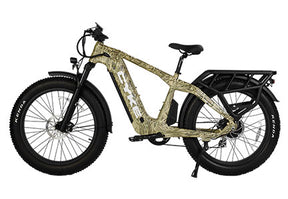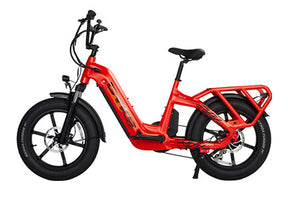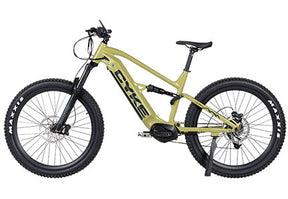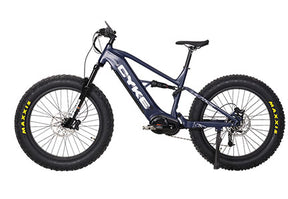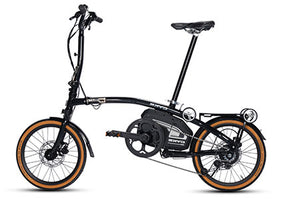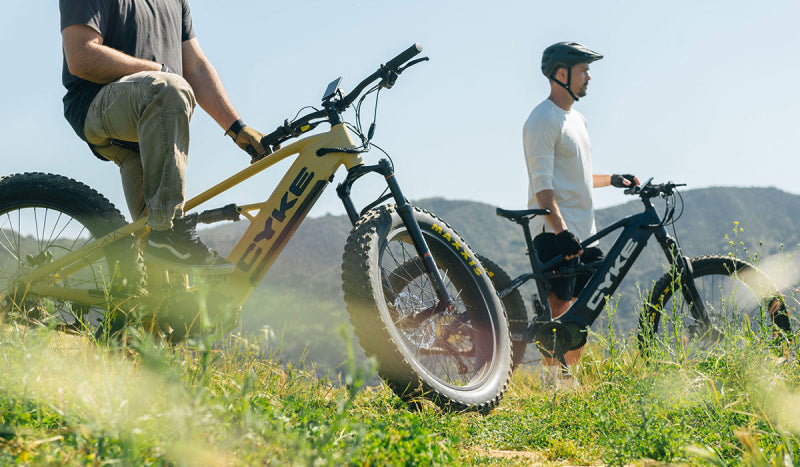Featured in this posts
Bike Frame Material Explained: 6061 Aluminum Alloy
If you are diving into the world of electric bikes, you’ve probably heard about 6061 aluminum alloy.
It’s lightweight, strong, and rust-resistant, making it a favorite among both manufacturers and riders. You’ll find it in everything from mountain and electric bikes to hunting and cargo trikes. It strikes a great balance between performance, durability, and cost, which is why it's so widely used.
Let’s break it down in a way that’s easy to understand. Whether you are a casual rider or a hardcore off-road enthusiast, this article will explain why 6061 aluminum is a top choice for bike frame material.
What Is 6061 Aluminum Alloy?
6061 aluminum alloy is not just plain aluminum. It’s a special blend of elements that makes it stronger, lighter, and more durable, perfect for tough applications like eBike frames.
Composition and Properties
6061 aluminum alloy is primarily made of aluminum, magnesium, and silicon, but it’s mixed with other elements to boost its performance. Here's a quick overview of its typical composition by weight:
|
Element |
Minimum (%) |
Maximum (%) |
|
Aluminum (Al) |
95.85% |
98.56% |
|
Magnesium (Mg) |
0.80% |
1.20% |
|
Silicon (Si) |
0.40% |
0.80% |
|
Iron (Fe) |
0.00% |
0.70% |
|
Copper (Cu) |
0.15% |
0.40% |
|
Chromium (Cr) |
0.04% |
0.35% |
|
Zinc (Zn) |
0.00% |
0.25% |
|
Titanium (Ti) |
0.00% |
0.15% |
|
Manganese (Mn) |
0.00% |
0.15% |
|
Others |
— |
0.15% total (0.05% each) |
This combo gives it some impressive traits. For starters, it has a fantastic strength-to-weight ratio. That means it’s strong enough to handle rough rides but light enough to keep your bike easy to maneuver.
It’s also highly resistant to corrosion, so you don’t have to worry about rust even if you ride in wet or muddy conditions. Finally, it welds neatly, which helps in making seamless frames.
They can shape and join the frame easily without compromising strength. These qualities make 6061 a favorite for bikes that need to be tough yet nimble.
What the “T6” Heat Treatment Means
When you hear “6061-T6” aluminum bike frame, the “T6” part refers to a specific heat treatment process. It boosts the alloy’s strength and durability; essentially, the metal is heated and cooled in a specific way to make it tougher.
For bike frames, T6-treated 6061 can handle the stress of heavy loads, bumpy trails, or long rides without cracking or bending. It’s like giving the frame a superpower to endure whatever you throw at it.
In short, T6 gives riders peace of mind that the frame will stand up to hard use, whether you are cruising on pavement or tackling rocky paths.
Comparing 6061 to Other Frame Materials
Now, let’s see how 6061 aluminum stacks up against other popular bike frame material. This will help you understand why it’s often the top pick.
6061 Aluminum vs. Carbon Fiber
Carbon fiber frames are lighter than aluminum by about 30%, and are often used in high-end road bikes.
By contrast, the 6061 frame is slightly heavier, but it’s way more affordable. Plus, aluminum is tougher in crashes. Carbon fiber can crack or shatter, while 6061 can bend rather than shatter, making repairs easier and take a beating and keep going.
This makes 6061 perfect for rugged uses like off-roading or hunting. If you are riding through trails or hauling gear, aluminum’s durability gives you peace of mind.
6061 Aluminum vs. Steel
Steel frames feel sturdy and absorb bumps well. Yet they weigh more. In fact, steel is significantly heavier than a 6061 aluminum bike. This is a big deal for eBikes, where batteries and motors already add weight.
A lighter frame means better handling and less strain on the motor. Steel might be great for touring bikes with heavy loads, but for agile, versatile rides, 6061 aluminum wins. It’s also low-maintenance, which is a bonus for busy riders.
Also, steel can rust if not protected. By contrast, 6061 resists corrosion, making it a top pick for e‑bikes.
6061 Aluminum vs. 7005 Aluminum
Both 6061 and 7005 are aluminum alloys, but they’re not the same. 7005 is slightly stronger but harder to bend into shapes and often needs special tube specs.
However, 6061 is easier to weld, shape, and source, making it more common in bike manufacturing. 7005 can be trickier to work with, which drives up costs.
For most riders, the strength difference is negligible; 6061 handles everyday stresses just fine. Its versatility and affordability make it the go-to for many brands.
Why CYKE Bikes Use 6061
Balancing Strength and Weight
6061 aluminum offers a great mix of durability and lightness. That’s important.
Why? Because you want a frame that’s tough enough to handle bumps, but light enough to pedal up a hill without feeling like you’re dragging a tank. 6061 gives you both.
Compared to steel, it’s significantly lighter. And, compared to carbon fiber, it’s more affordable. It’s that middle ground that makes it such a great choice.
This balance also makes your ride smoother and easier to control. Less weight means quicker starts, easier climbs, and better handling overall. And that’s something both casual riders and seasoned cyclists can appreciate.
The frame’s strength supports dynamic riding without adding unnecessary bulk. For both bikes, 6061 ensures you get power and agility in one package.
Durability for Demanding Terrain
CYKE eBikes are tough and made to last. If you're riding over potholes, gravel trails, or rough terrain, your bike frame needs to stand up to stress.
Here, CYKE’s 6061 aluminum can handle repeated impacts without cracking. It doesn’t wear out quickly. Plus, it's more resistant to corrosion than some other metals. So even if you're caught in the rain or ride near the ocean, the frame holds up well.
That kind of durability means fewer repairs and longer use. You get more value out of your bike.
Engineering Flexibility & Design Advantages
6061 aluminum isn’t just good for performance. It also makes life easier for the people who design and build bikes.
Welding, Shaping, and Foldability
6061 is easy to work with. Because it is so workable, manufacturers can shape the frame into a variety of designs. Want a low-step frame that’s easy to get on and off? Prefer a sleek racing frame? That works too.
It also welds well. Smooth welds aren’t just about looks; they make the frame stronger and reduce weak points. And since 6061 can be heat-treated, the finished frame gets even more durable after it's built.
For folding bikes or compact designs, 6061 is ideal. It allows precise engineering without adding unnecessary weight.
In short, it helps designers get creative while keeping bikes functional and safe.
Long-Term Reliability and Low Maintenance
Another big win for 6061 aluminum is how well it holds up over time.
First, it resists corrosion. Unlike steel, which can rust if the paint chips, 6061 stands up to moisture. That’s a big plus for riders who store their bikes outdoors or ride in wet climates.
Second, it has excellent fatigue resistance. That means the material doesn’t weaken quickly with repeated use. You can ride it hard, ride it often, and still trust your frame years later.
And since it's not prone to rust or cracking, maintenance is easier. No need for constant inspections or touch-ups. Just clean it, keep it dry, and you’re good to go.
So, for people who want a reliable, low-hassle bike, whether for commuting, fitness, or fun, 6061 is a solid choice.
Final Thoughts
So, there you have it, 6061 aluminum alloy is one of the most trusted bike frame material in manufacturing, and for good reason. It offers the ideal blend of strength, weight, and versatility.
Whether you're a casual cyclist or a daily commuter, it provides the performance and reliability you need and ensures your bike can keep up.
Compared to carbon fiber, steel, or even 7005 aluminum, it strikes an ideal balance of performance and affordability. Next time you are shopping for a bike, look for 6061 aluminum; you’ll know it’s built to last.
